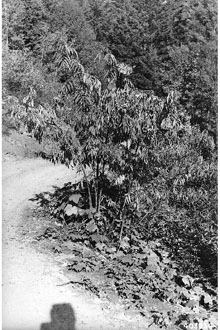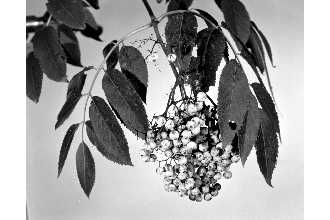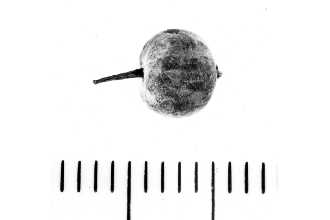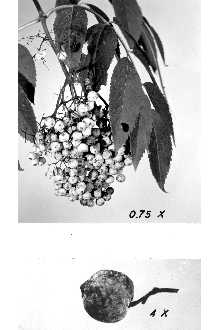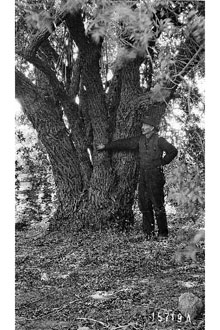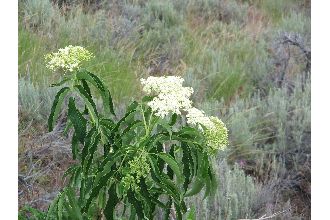Sambucus cerulea Raf.
Scientific Name: Sambucus cerulea Raf.
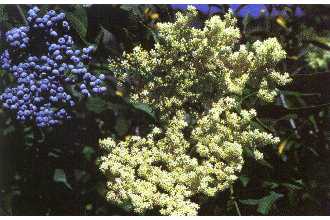
| General Information | |
|---|---|
| Usda Symbol | SACE3 |
| Group | Dicot |
| Life Cycle | Perennial |
| Growth Habits | ShrubTree, |
| Native Locations | SACE3 |
Plant Guide
Uses
Ethnobotanic: Only the blue or purple berries of elderberry are edible. Edible berries and flower are used for medicine, dyes for basketry, arrow shafts, flute, whistles, clapper sticks, and folk medicine. The active alkaloids in elderberry plants are hydrocyanic acid and sambucine. Both alkaloids will cause nausea so care should be observed with this plant. Elderberries are high in vitamin C. The red berries of other species are toxic and should not be gathered. The wood is hard and has been used for combs, spindles, and pegs, and the hollow stems have been fashioned into flutes and blowguns. Elderberries are quite edible. The blue or purple berries are gathered and made into elderberry wine, jam, syrup, and pies. The entire flower cluster can be dipped in batter and fried, while petals can be eaten raw or made into a fragrant and tasty tea. The flowers add an aromatic flavor and lightness to pancakes or fritters. Botany Dept., NMNH, Smithsonian Institution @ PLANTS The elderberry is of well-known value to the Indians of North America and the many purposes it serves (Barrow 1967). Elderberry is highly prized by both Spaniards and Cahuillas. Throughout the months of July and August, the small clusters of berries are gathered in large quantities. These clusters are dried carefully on the drying floor and preserved in considerable amounts. When wanted, they are cooked into a rich sauce that needs no sweetening. A Cahuilla family, during this season of the year, will subsist largely on these messes of "sauco." Frequently, the elderberry was so greatly enjoyed that families would live for weeks on little else. Many were dried for use in the winter, and were either re-cooked or eaten raw. Elderberries are still highly prized for food by modern Indian people. Elderberry twigs and fruit are employed in creating dyes for basketry. These stems are dyed a very deep black by soaking them for a week or so in a wash made from the berry stems of the elderberry (Barrows 1967). The Cahuilla split basketry materials from the aromatic sumac (Rhus trilobata). Elderberry branches were used to make the shaft of arrows. Flutes and whistles were constructed by boring holes into stems hollowed out with hot sticks. Clapper sticks were made by splitting the stem and clapping the two halves against each other. Clapper sticks were used ceremonially in the round-house to accompany singing and dancing. The pith of the stems was used as tinder, and the stem itself was employed as a twirling stick for starting the fire. Hollowed-out elderberry stems can be made into squirt guns. In the middle ages, elderberry was considered a Holy Tree capable of restoring good health, keeping good health, and as an aid to longevity. Fruits of blue elderberry are gathered from the wild for wine, jellies, candy, pies, and sauces. The plants are commercially cultivated for fruit production in Oregon. Sambucus canadensis and S. nigra have long been used in the same way, and cultivars of both have been developed. All parts of the elderberry plant are considered to be a valuable healing plant in many folk medicine traditions (Hutchens 1991, Walker et al. 1993; Barrett et al. 1933; Clarke 1977). Elderberry flowers contain flavenoids and rutin, which are known to improve immune function, particularly in combination with vitamin C. The flowers also contain tannins, which account for its traditional use to reduce bleeding, diarrhea, and congestion. The flowers are the mildest part of the plant and when prepared as a tea, are used to break dry fevers and stimulate perspiration, aid headache, indigestion, twitching eyes, dropsy, rheumatism, appendix inflammation, bladder or kidney infections, colds, influenza, consumption (bleeding in lungs), and is helpful to newborn babies (Hutchens 1991). Used as a wash, the flowers or leaves are good for wounds, sprains, and bruises, as well as for sores on domestic animals. The leaves, which are stronger, have a slightly laxative property. Applied externally, leaves, flowers, bark and twigs are excellent as a poultice, mixed equally with chamomile, for soreness, inflammations, joint stiffness, and to reduce the swelling of bee stings. The flowers and berries, employed as a diuretic, can aid arthritis and rheumatism. Steeped in water, the flowers are used externally to aid in complexion beauty, tone and soften the skin, and lighten freckles or spots. The berry juice made into salve aids burns and scalds. The juice taken internally will act as a purgative. Livestock: Blue elderberry is a useful range plant for domestic livestock, but is not equally palatable during all seasons. It usually receives limited browsing in the spring and to a much greater extent in the late summer and fall. The leaves are eagerly devoured after the first heavy frost in the fall. Because many branches are beyond the reach of the animals, utilization is less destructive. Browse rating: Good for goats; good to fair for sheep; good to poor for deer; fair for cattle; and fair to poor for horses (Sampson and Jesperson 1981). Wildlife: Structurally complex riparian vegetation communities provide many different habitats and support a diverse array of animal species. Different groups of animals occupy or use the different layers of vegetation, and this multi-story arrangement is often present nowhere else in the arid landscapes. Canopies of plants growing on stream banks provide shade, cooling stream water, while roots stabilize and create overhanging banks, providing habitat for fish and other aquatic organisms. Game birds, squirrels and other rodents, and several kinds of browsers also feed on the fruit or foliage of elderberry. Bears love to eat the elderberry fruits while deer, elk, and moose browse on the stems and foliage. The elderberries are important sources of summer food for many kinds of songbirds. For example, the western bluebird, indigo bunting, common house finch, red-shafted flicker, ash-throated flycatcher, black-headed grosbeak, scrub jay, Stellar jay, ruby-crowned kinglet, mockingbird, red-breasted nuthatch, Bullock’s oriole, hooded oriole, song sparrow, white-crowned sparrow, western tanager, California thrasher, russet-backed thrush, brown towhee, Audubon warbler, cedar waxwing, Lewis and Nuttall's woodpecker, wren-tit, grouse, pheasant, and pigeons all eat elderberries (Martin et al. 1951). The valley elderberry longhorn beetle (VELB) (Desmocerus californicus dimorphus) was listed as threatened under The Endangered Species Act on August 8, 1980. The elderberry beetle is endemic to moist valley oak riparian woodlands along the margins of rivers and streams in the lower Sacramento and upper San Joaquin Valley of California where elderberry grows. The primary threat to the VELB is loss of habitat, insecticide and herbicide use, and lack of elderberry shrubs/trees as a food plant for the beetle. The mitigation for VELB habitat loss, considered a taking under The Endangered Species Act, is quite stringent (U.S. Fish and Wildlife Service Mitigation Guidelines). In general, longhorn beetles are characterized by somewhat elongate and cylindrical bodies with long antennae, often in excess of 2/3 of the body length. Male VELB have a metallic-green pattern of 4 oblong maculations, surrounded by a bright red-orange border. The body length is about 13-21 mm, and antennae are about as long as the body. Females are more robust, with body length about 18-25 mm, and the dark pattern is not reduced. Blue elderberry is planted because of its forage and cover value, productivity, adaptability, and ease of establishment. It is a useful ground cover for stabilizing streambanks and eroding sites. It provides food, cover, perching, and nesting sites for many species of birds and food and cover for various other wildlife, and it is important as browse for mule deer and elk. In the spring, the leaves may be strongly scented and less palatable, but they sweeten and become more palatable by fall.
Status
Please consult the PLANTS Web site and your State Department of Natural Resources for this plant’s current status, such as, wetland indicator values. Western riparian ecosystems have been greatly altered by human activity. Riparian forests have been reduced to fragmented, discontinuous patches because of human intervention. For example, estimates are that 70 - 90 percent of the natural riparian ecosystems in the U.S. have been lost to human activities. Regional losses in these ecosystems have been estimated to exceed 98% in the Sacramento Valley in California. Many factors have contributed to these resource losses, including the following: natural resource use; urbanization; alteration of stream flows through dam construction and ground-water withdrawal; modification of biotic conditions through grazing, agriculture, introduction of non-native species; and alteration within watersheds.
Description
General: Honeysuckle family (Caprifoliaceae). Native shrubs growing 2-4(-8) m tall, less commonly small single-stemmed trees, young twigs soft and pithy but the wood hard; bark thin, grayish to dark brown, irregularly furrowed and ridged. The pinnately compound leaves are deciduous, opposite, about 15-35 cm long, odd-pinnate with (3-)5-9 serrate leaflets 2-15 cm long, often with a long stalk, often asymmetrical at the base. Elderberry leaves, especially on seedlings or shrub-sized plants (without fruits or flowers) resemble California walnut (Juglans hindsii) and Oregon ash (Fraxinus latifolia). The inflorescence is flat-topped, 4-20(-30) cm across, broader than high; flowers bisexual, the corollas small, white to cream, rotate, 5-lobed, with a pleasant, yet slightly rancid odor. Fruit is berry-like, 5-6 mm wide, with 3-5 nutlets, blue- to purple-black at maturity with a white-waxy bloom and appearing powder blue. The common name “elder” is from the Anglo-Saxon “ellen,” meaning fire-kindler, the dry, pithy stems; blue from the fruit color. Variation within the species: A recent proposal treats Sambucus caerulea within a broader species concept – where it is considered the western US segment of S. nigra L., a species covering all of North America and extending into Europe. Ssp. canadensis (L.) R. Bolli (= S. canadensis L.) is the eastern US entity of S. nigra, extending westward into the Great Plains nearly to the eastern edge of the Rocky Mountains. Ssp. nigra is the Old World entity but it also occurs in Greenland, Newfoundland, and a few other localities in northeastern North America. Several varieties have been described within Sambucus caerulea, although they are not currently accepted: Var. caerulea Var. neomexicana (Woot.) Rehd. – New Mexican elderberry Var. velutina (Dur. & Hilg.) Schwerin – Dwarf Elder Some familiar with elderberry in the western US, however, remain convinced that more than a single entity is represented within “var. caerulea,” differing in habitat and biological features (e.g., see http://www.laspilitas.com/plants/619.htm). Distribution: Blue elderberry is common along stream banks, river banks, and open places in riparian areas lower than < 3000 m. From west Texas north to Montana, western Alberta, and southern British Columbia, and all other western states, south into northwest Mexico. For current distribution, please consult the Plant Profile page for this species on the PLANTS Web site.
Adaptation
Blue elderberry grows on moist, well-drained sunny sites, usually occurring in early seral communities or in openings in moist forest habitats (slopes, canyons, cliff bases, streamsides, streambanks) and moist areas within drier, more open habitats (sagebrush, mountain brush, pinyon-juniper, ponderosa pine, often along fence rows and roads); at elevations of 3-3000 meters, Blue elderberry is a dominant understory species in riparian woodlands, It can persist past seral stages as scattered individuals in open forests, woodlands, chaparral, or riparian zones, This species flowers from May to September and fruits from July to October, Blue elderberry is more common on warmer sites than red elderberry (Sambucus racemosa), although they overlap in habitat preference, In California, common riparian woodland associates are valley oak (Quercus lobata), interior live oak (Quercus wislizenii), California walnut (Juglans hindsii), and California sycamore (Platanus racemosa), Box elder (Acer negundo), Oregon ash (Fraxinus latifolia), alder (Alnus rhombifolia), and willow (Salix gooddingii, Salix exigua, Salix lasiandra, and Salix laevigata) are particularly prevalent in the subcanopy, Understory species are mostly shrubs, including elderberry (Sambucus mexicana), buttonbush (Cephalanthus occidentalis), blackberry (Rubus spp, Use soil moisture sensors to measure the soil moisture of Sambucus cerulea Raf..,), and California rose (Rosa californica), Lianas, such as poison oak (Toxicodendron diversiloba) and California grape (Vitis californica) are a dominant feature, Herbaceous vegetation is 1% cover except in openings where tall forbs may occur,
Establishment
Blue elderberry produces a good seed crop almost every year. The seeds are dispersed by birds and other animals that eat the fruit. The seeds have a hard seed coat and embryo dormancy and may remain viable for up to 16 years in storage. Without pretreatment, seed germination may be delayed from 2 to 5 years after planting. Plants may flower and fruit after only 2-3 years and can reach full size in 3-4 years. They are said to be “short-lived.”
Vegetative
reproduction is limited to coppicing if the stems are killed or injured. Seeds: • Blue elderberry grows best from seed. • Elderberry fruits are collected when ripe and spread in thin layers to dry. • To separate seeds from fruits either 1) run fruit through a macerator with water, the pulp and empty seeds float; 2) crush, dry and use without separating fruits and seeds; and 3) small amounts of fruit can be cleaned in a fruit blender. • Elderberry seed can be stored dry at 41 °F for several years. • Elderberry seeds can be sown in the fall soon after collection, or stratified and sown in the spring. In either case, germination is often not complete until the second spring. • A seedling density of 35 plants per square foot is sought. Seeds are sown 1/4 inch deep in drills and covered with about 3/8 inch of sawdust mulch. • In the greenhouse, seeds are warm stratified for two months in a mixture of peat, vermiculite, and sand at 21° to 30°C; (70 to 85°F). Seeds are then placed close to the soil surface in flats in the greenhouse. There are usually several hundred seeds in one seed flat. • Seedlings are then potted from the flats in deep 3" pots. • After one season of growth, the seedlings are field planted in the fall or spring when they are 6 to 8 months old. If planted in the fall, irrigation may not be necessary in moist sites. In drier sites or with spring planting, irrigation will be required for seedling establishment. Cuttings: • Cuttings of elderberry tend to have lower survival success than establishment from seed. • Use hardwood cuttings from previous seasons growth. • Take "heel cuttings" from older wood, so inner pith is not exposed. • Cuttings should be at least 10", and have at least two nodes. Cuttings should be placed in 4" pots with perlite and peat. Plants should be kept moist. • Cuttings have a fragile root system, with high mortality occurring when transplanted. Care should be taken to be very gentle with delicate roots when transplanting. • The cuttings that survive seem to establish and grow faster. Plant biomass production, height, flowering and seed set is more rapid than with seedlings. Transplanting Trees and Stems: • All elderberry plants with evidence of valley elderberry longhorn beetle use (i.e. emergence holes or presence of adults) should be transplanted, as they provide habitat for a threatened species under The Endangered Species Act. For further technical information, call a representative of the U.S. Fish and Wildlife Service. • Cut tree back to 3 to 6 feet from the ground or to 50 percent of its height (whichever is greater) by removing branches and stems above this height. The trunk and all stems greater than 1.5 inches in diameter can be replanted. • If the presence of tunnels excavated by the beetle larvae inside the elderberry stem and trunk are detected, place pruned material next to transplanted elderberries. • Move plant by the root ball. Keep the root ball wet. • Place transplant in holes 3 to 4 feet deep. • Construct circular water retention basin from the excavated earth about 8-10 feet in diameter and 12 to 14 inches high. Plant the main trunk of an elderberry in the center of each water basin. Plant other stems that have been rooted around the circumference of the basin. • Saturate soil with water. Irrigate as necessary, especially through first growing season.
Management
In six riparian restoration projects carried out in California, competition from exotic weed species was a key factor in mortality and site failure (Baird 1989). On small sites, hand weeding around trees and shrubs is the most effective means of weed control. One way to avoid competition from weeds on larger sites is to remove the surface soil, although this has the disadvantage of removing nutrients, mycorrhizal fungi, bacteria, and insect and invertebrate populations critical to a healthy habitat. A cover crop of native wildflowers was also used to control weeds, with wildflower seeds hand-broadcast over the site. On wetter, heavier soils this does not seem to provide effective weed control. There is considerable evidence that fertilization can favor exotic weeds over native plants. Inoculation with mycorrhizal fungi enables seedlings of some species to better utilize limited supplies of both water and nutrients. Inoculation of transplanted shrubs may be accomplished through inclusion of large (1.2 m deep by 2.8 m wide) root balls with plants. Smaller, more economical soil plugs scattered throughout the site serve the same purpose. The number of soil plugs needed to ensure the establishment of soil flora is directly related to the distance of the restoration site from a similar, mature community. Given that elderberry provides habitat for the federally listed valley longhorn elderberry beetle, livestock grazing of elderberry is not recommended. Livestock grazing can alter vegetative structure and composition of riparian habitat. Overgrazing by livestock and big game frequently changes plant species composition and growth form, density of stands, vigor, seed production of plants, and insect production. Clear-cutting or seed tree cutting with high soil disturbance sometimes favors the development of blue elderberry in a seral community. It recovers well from heavy grazing in the Great Basin. For use in site stabilization or rehabilitation, seeds may be planted directly or seedlings and 1-2-year old stock may be transplanted. It also grows from transplanted seedlings, cuttings, and rootstocks. Blue elderberry usually is not present in the understory of closed-canopy forests. When fire occurs in these, regeneration occurs from seed banks that may occur between 2-10 cm deep in the soil. The seeds deposited are from off-site dispersal or from plants of an earlier community. Fire scarifies the hard seed coat of buried seeds and stimulates their germination, which usually occurs the first growing season after the fire. Subsequent burns may eliminate blue elderberry since it spreads slowly by seed. Fire kills above-ground parts but the root crown may sprout. A severe fire can kill the root and stem buds from which sprouting occurs. Cultivars, Improved and Selected Materials (and area of origin) These plant materials are somewhat available from commercial sources. Contact your local Natural Resources Conservation Service (formerly Soil Conservation Service) office for more information. Look in the phone book under ”United States Government.” The Natural Resources
Conservation
Service will be listed under the subheading “Department of Agriculture.”
References
Arnold, R.A. 1984. Interim report for contract C-616 with the California Department of Fish and Game. 14 pp. Baird, K. 1989. High quality restoration of riparian ecosystems. Restoration and Management Notes 7(2):60-64. Barrett, S.A. & E.W. Gifford 1933. Miwok material culture. Indian Life of the Yosemite Region. Yosemite Association, Yosemite National Park, California. 387 pp. Barrows, D.P. 1967. Ethno-botany of the Coahuilla Indians. Malki Museum Press. Banning, California. 82 pp. Bolli, R. 1994. Revision of the genus Sambucus. Dissert. Bot. 223:1-227. Burke, H.E. 1921. Biological notes on Desmocerus , a genus of roundhead borers, the species of which infests various elders. J. Econ. Ent. 14:450-452. Clarke, C.B. 1977. Edible and useful plants of California. University of California Press. 280 pp. Crane, M. F. 1989. Sambucus cerulea. IN: W.C. Fischer (compiler). The fire effects information system [Database]. USDA, Forest Service, Intermountain Research Station, Intermountain Fire Sciences Laboratory. Missoula, Montana. <http://www.fs.fed.us/database/feis/> Cronquist, A., A.H. Holmgren, N.H. Holmgren et al. 1984. Intermountain flora: Vascular plants of the Intermountain West, U.S.A. Vol. 4. Subclass Asteridae, (except Asteraceae). The New York Botanical Garden. New York, New York. Eriksson, T. & M.J. Donoghue 1997. Phylogenetic relationships of Sambucus and Adoxa (Adoxoideae, Adoxaceae) based on nuclear ribosomal ITS sequences and preliminary morphological data. Syst. Bot. 22:555-574. Felter, H.W. & J.U. Lloyd 2000. Sambucus. IN King’s American Dispensatory. Web site. <http://metalab.unc.edu/herbmed/eclectic/kings/sambucus.html> Finn, C. 1999. Temperate berry crops. Pp. 324–334. IN: J. Janick (ed.), Perspectives on new crops and new uses. ASHS Press, Alexandria, Virginia. <http://www.hort.purdue.edu/newcrop/proceedings1999/v4-324.html#elderberry> Hartmann, H.T., D.E. Kesler, & F.T. Davies, Jr. 1990. Plant propagation principles and practices. Prentice Hall, Englewood Cliffs, New Jersey. 647 pp. Hickman, J.C. (ed.) 1993. The Jepson manual. Higher plants of California. University of California Press. 1400 pp. Hutchens, A.R. 1991. Indian herbalogy of North America. Shambhala Books, Boston and London. pp 114-117. Martin, A.C., H.S. Zim, and A.L. Nelson 1951. American wildlife and plants: A guide to wildlife food habits. Dover Publications, Inc., New York, New York. 500 pp. Munz, P.A. 1968. A California flora. University of California Press. 224 pp. Murphy, E.V.A. 1959. Indian uses of native plants. Mendocino County Historical Society. 81 pp. Powers, S. 1976. Tribes of California. University of California Press. 480 pp. Roos-Collins, M. 1990. The flavors of home. A guide to wild edible plants of the San Francisco Bay area. Heyday Books, Berkeley, California. 224 pp. Sampson, A.S. & B.S. Jesperson 1981. California range brushlands and browse plants. Agricultural Sciences Publications. University of California. Berkeley, California. 162 pp. Schopmeyer, C.S. 1974. Seeds of woody plants in the United States. Agriculture Handbook No. 450. Forest Service, U.S. Department of Agriculture. Washington, D.C. 883 pp. Walker, P.L. & T. Hudson 1993. Chumash healing. Changing Health and Medical Practices in an American Indian Society. Malki Museum Press, Banning, California. 161 pp.
Plant Traits
Growth Requirements
| Moisture Use | Low |
|---|---|
| Adapted to Coarse Textured Soils | Yes |
| Adapted to Fine Textured Soils | No |
| Adapted to Medium Textured Soils | Yes |
| Anaerobic Tolerance | Medium |
| CaCO3 Tolerance | Medium |
| Cold Stratification Required | Yes |
| Drought Tolerance | High |
| Fertility Requirement | Low |
| Fire Tolerance | Medium |
| Frost Free Days, Minimum | 80 |
| Hedge Tolerance | Low |
| pH, Maximum | 7.5 |
| pH, Minimum | 4.9 |
| Planting Density per Acre, Maxim | 3450 |
| Planting Density per Acre, Minim | 1746 |
| Precipitation, Maximum | 60 |
| Precipitation, Minimum | 10 |
| Root Depth, Minimum (inches) | 12 |
| Salinity Tolerance | None |
| Shade Tolerance | Intermediate |
| Temperature, Minimum (°F) | -38 |
Morphology/Physiology
| Bloat | None |
|---|---|
| Shape and Orientation | Erect |
| Toxicity | Moderate |
| Active Growth Period | Spring and Summer |
| Coppice Potential | No |
| Fall Conspicuous | No |
| Fire Resistant | No |
| Flower Color | White |
| Flower Conspicuous | Yes |
| Foliage Color | Green |
| Foliage Porosity Summer | Moderate |
| Foliage Texture | Coarse |
| Fruit/Seed Color | Black |
| Growth Form | Multiple Stem |
| Resprout Ability | Yes |
| Nitrogen Fixation | None |
| Low Growing Grass | No |
| Lifespan | Moderate |
| Leaf Retention | No |
| Known Allelopath | No |
| Height, Mature (feet) | 23.0 |
| Height at 20 Years, Maximum (fee | 23 |
| Growth Rate | Rapid |
| Fruit/Seed Conspicuous | Yes |
Reproduction
| Vegetative Spread Rate | Moderate |
|---|---|
| Small Grain | No |
| Seedling Vigor | High |
| Seed Spread Rate | Moderate |
| Fruit/Seed Period End | Fall |
| Seed per Pound | 197590 |
| Propagated by Tubers | No |
| Propagated by Sprigs | No |
| Propagated by Sod | No |
| Propagated by Seed | Yes |
| Propagated by Corm | No |
| Propagated by Container | Yes |
| Propagated by Bulb | No |
| Propagated by Bare Root | Yes |
| Fruit/Seed Persistence | No |
| Fruit/Seed Period Begin | Summer |
| Fruit/Seed Abundance | High |
| Commercial Availability | Contracting Only |
| Bloom Period | Spring |
| Propagated by Cuttings | No |
Suitability/Use
| Veneer Product | No |
|---|---|
| Pulpwood Product | No |
| Post Product | No |
| Palatable Human | Yes |
| Palatable Graze Animal | Low |
| Palatable Browse Animal | Low |
| Nursery Stock Product | Yes |
| Naval Store Product | No |
| Lumber Product | No |
| Fodder Product | No |
| Christmas Tree Product | No |
| Berry/Nut/Seed Product | No |

